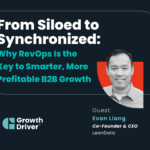Congratulations enterprise marketers! You are no longer confined to being a “cost center.” Now, marketing teams are increasingly expected to be a growth driver. (Easier said than done, right?)
But let’s be real, a critical step in this transformation is adopting the modern mindset of sales enablement. While marketing may not close deals directly–after all we did choose to be marketers, not sellers–our influence spans every stage of the sales process. By collaborating effectively with sales, enterprise marketers can empower their sales counterparts to work their magic and close more deals.
Here are 5 tips for marketers looking to make this essential shift:
1. Address the Whole Sales Enablement Spectrum
Sales enablement isn’t one-size-fits-all; the type of support required varies across transactional, consultative, and relationship-driven sales.
For seasoned, relationship-driven sellers, scripts aren’t necessary. These professionals excel at nurturing prospects and building trust. But they do need timely insights about market shifts, competitor innovations, and potential disruptions that could derail their conversations. We can support them by curating resources that help sellers navigate these market shifts and keep their conversations productive.
For more transactional sales environments, marketing’s role may lean toward providing standardized content and streamlined processes that enable sellers to act quickly and effectively. Think case studies or efficient account-based (ABM/ABX) plays.
2. Leverage Data to Fuel Sales Enablement
Data is at the core of modern sales enablement. First- and third-party data can help sales teams prioritize opportunities and develop a more targeted approach.
However, the key isn’t simply providing all the data available—it’s passing off the right data, after you translate it into a story with color, context, and clear next steps for that seller.
For example, instead of handing sales a massive list of leads or the latest whitepaper download, deliver a prioritized list based on intent signals and buyer behaviors. Add context about why these leads are high-priority and how to approach them, ensuring sellers can act swiftly and confidently.
3. Overcome the Pain of Doing Nothing
One of the biggest challenges in enterprise sales is overcoming a prospect’s inertia. “Doing nothing” is a lot less scary than making a change. This is known as status quo bias.
Marketers can help sales teams engage decision-makers early in their buying journey, even before those decision-makers realize (or accept) they have a problem worth solving.
With the bulk of the buyer’s journey taking place online and anonymously, it’s critical for marketing to provide account-level insights as early as possible. This could include tracking digital engagement signals, identifying key decision-makers, and crafting personalized campaigns that capture attention during the research phase. By doing so, sales teams can act preemptively and position themselves as trusted advisors before the competition gets a chance.
4. Bridging the Sales-Marketing Gap
Enterprise sales professionals are often highly experienced and have finely tuned processes. For marketers, building trust starts with listening and observing.
Instead of jumping into ideas for improvements or introducing new content, ask to sit in on a discovery meeting or a pitch. Understand their workflows, challenges, and goals firsthand. From there, identify ways to add strategic value by simplifying processes, enhancing personalization, or filling gaps in their toolkits—not by inundating them with more content or noise.
When marketing proves they’re invested in helping sales succeed, trust and alignment naturally follow.
5. Use Technology to Unify and Simplify
Technology can be a powerful unifier between sales and marketing—if implemented correctly. One of the biggest barriers to alignment is a lack of shared goals and metrics. For example, have you ever shared that you hit your engagement goal by 106%, only to be asked how much revenue that email generated?
Aggregating data into a single source of truth ensures both teams are working toward the same objectives and using the same KPIs to measure success. This starts by creating a shared definition of what those metrics are, then each team can break out impacting activities within their departments.
For example, integrating CRM and marketing automation platforms can provide real-time visibility into lead activity, engagement, and readiness to buy. Simplifying workflows and creating dashboards tailored to sales needs drives adoption and ensures both teams are on the same page.
Power to You, Enterprise Marketer
Building alignment between marketing and sales in an enterprise environment is no small task. The sheer size and complexity of these organizations can create barriers to collaboration.
Thankfully, alignment often starts with a simple step: walking down the hall (or sending a meeting invite) to hash out a shared definition of success.
Once sales and marketing agree on how to measure success, integrating data and implementing marketing-fueled sales enablement strategies becomes a natural next step. By addressing the sales enablement spectrum, leveraging data, engaging decision-makers early, and building trust, marketers can help turn their organization’s sales engine into a well-oiled machine—and redefine their role as a true growth driver.
See it in action
To see how Mike Lempko, Senior Director of Marketing Operations at Vizient, redefined how he helped transformed marketing to fuel their enterprise sales team, tune into our conversation with him on Growth Driver.




